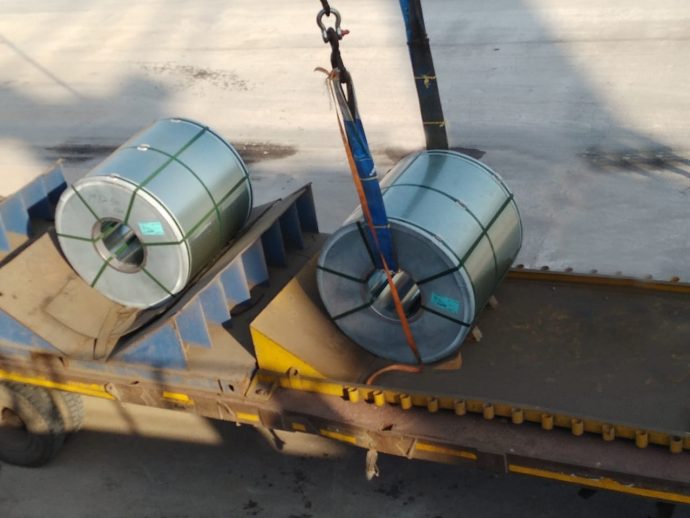Steel is the foundation of nearly all industrial activity worldwide. It is simple and plentiful but requires the most specialised and careful handling as cargo.
The metal is typically heavier, more rigid and more vulnerable to damage than other forms of dry bulk. And that means that it takes meticulous planning, bespoke equipment and attention to detail to support safe and efficient global steel trade.
Complexity
There is no one-size-fits-all approach to steel loading. It is shipped in a range of forms, including coils, beams and scrap metal – and that makes dealing with it complicated.
Most processed steel is transported as either cold-rolled or hot-rolled coils. However, steel products typically used in construction projects, such as profiles, girders, channels and sheet piling, as well as raw steel products such as ingots, slabs, billets and rebars, are also often loaded onto ocean-going vessels.

Weather damage is one of the major issues when it comes to handling steel cargoes. Hatches need to be watertight before loading and have sufficient ventilation to reduce the chance of cargo and ship sweating and rusting.
Loading and unloading operators must be vigilant. Dedicated port facilities for steel cargo transport have specialist stowage and securing equipment, as well as skilled stevedores to monitor cargo conditions and provide prompt guidance throughout operations.
If these infrastructural elements are unavailable, extreme care and precision have to be taken by all involved, including the terminal and ship's master, to ensure the cargo is handled correctly.
That’s why loading and unloading of steel is much slower compared to other bulk cargoes. On average, between 4,000 and 8,500 MT of steel cargo can be moved each day compared to up to 20,000 MT/day for traditional bulk cargo.
“Quick turnaround times for vessels is vital for port operations due to the high demand for berths,” says Karen Huang, Shipping Operations Executive at GAC China. “Any delays, no matter how minor, can affect waiting vessels and even lead to demurrage charges for charterers.”

Preventing damage
The consequences of damage or injury are high and unpredictable. Everyone involved must be aware of the extreme care required to ship steel.
GAC provides its customers with dry cargo agency services worldwide. Whether it's shipping coal to Asia, food products from North America or heavy wind farm components to Europe, GAC has a part to play. Its history with a range of essential commodities such as gypsum, coal, mineral ores, cement, chemical, grain and project heavy lift shipments means it has the expertise and the flexibility to support those working in the dry bulk sector.

The Group's flexibility and transparency means customers can rely on their handling of steel cargo. Further, it can draw on its global network, experience and resources to tailor services to specific freights, routes, time scale and voyage numbers.
Careful handling
GAC continuously monitors cargo operations between the port and vessel to optimise productivity and turnaround times, allowing for resources to be adjusted and directed according to requirements. For steel cargo, this means ensuring all those involved in the loading and unloading process have sufficient professional experience to ensure that the cargo is not damaged.
"Everyone involved in handling steel cargoes – from gear suppliers, stevedoring companies and transporters – must be briefed fully about the operations involved and safety precautions," says Sankar Narayanan, Senior Manager – Shipping at GAC India.
"It's not just a question of smooth commerce, but also employee welfare. It is important to ensure that they have handled similar consignments before by following all safe working practices.”

The importance of the plan
Prior to a vessel’s arrival, a loading master will prepare a preliminary stowage plan that includes lashing and securing methods for the vessel owner and charterer’s review. Based on that plan, the decision will be made about the best cargo stowage methods, taking into account factors such as the vessel’s stability and port rotations; cargo quantity, type, weight, size and stackability; and how watertight the hold is.
“Planning for effective stowage, no matter the cargo, is a meticulous process. In general, we plan to load the cargo in the bottom hold first, then on the upper deck. We also prioritise cargo that will be discharged later, as well as goods that arrive in large quantities or more vulnerable to the impact of pressure resistance,” adds Karen.
When the GAC China team provided stowage support to a customer loading steel pipes at Tianjin Port, the preliminary stowage plan was not ideal, so they rearranged the placement of cargo like steel pipes and wooden cases across the ship’s deck and holds to optimise stowage based on its unique handling requirements.
Local steel stowage requirements may be adjusted from time to time to improve operational safety. It is therefore critical, from the planning stage, to work with a dependable ship agent with comprehensive understanding of local and international requirements related to the cargo and the vessel it is being loaded/unloaded. In India, GAC uses market research tools, including commodity-based line-ups, delay analyses, tonnage updates and industry trends, to help customers stay updated and able to plan for effective operations.